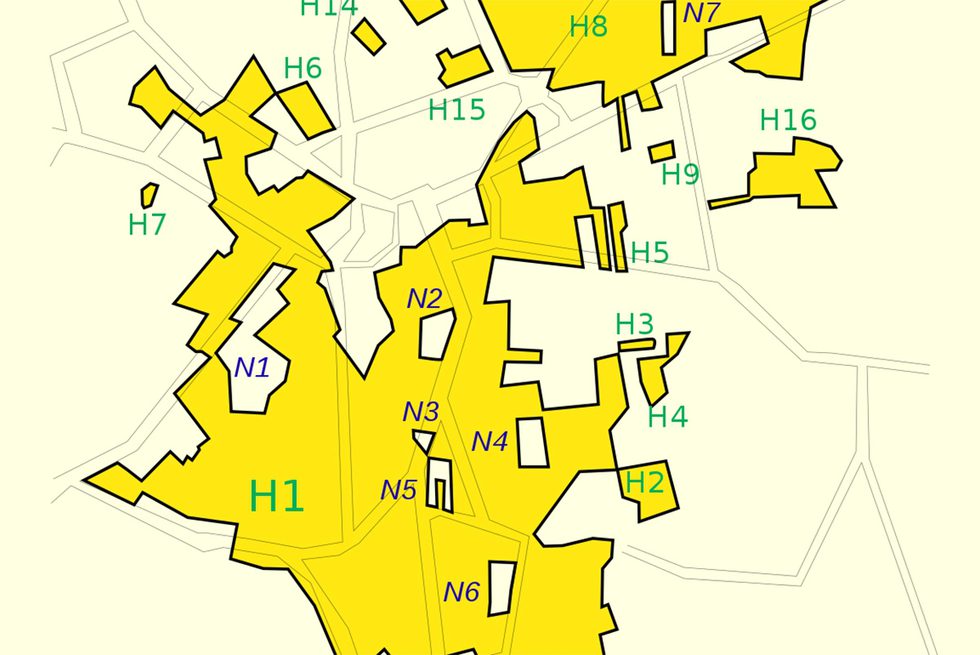Sectional
From the Series: Speaking Volumes
From the Series: Speaking Volumes

Baarle-Hertog and Baarle-Nassau are two cities enmeshed into one another. Baarle-Hertog is Belgian territory, surrounded—and fractured—by Baarle-Nassau, a city in the Netherlands. The situation is complicated further by the presence of counter-enclaves: plots of Dutch territory within Belgian territory, itself within Dutch territory. This particular territorial monster is an intricate jigsaw puzzle where each piece belongs to one of two nation-states.

Unlike the complex of enclaves, counter-enclaves, and counter-counter-enclaves that until recently dotted the India-Bangladesh border and in which communities found themselves stranded (Cons 2016), Baarle is a place devoid of local and colonial anxieties. As a result, Baarle tends to be dismissed as irrelevant and gimmicky by most border theorists. Yet the logic that sustains Baarle is the same that we find at work in all nation-states, namely that every inch of the territory must be controlled and that borders should be unambiguously marked.
What makes Baarle especially striking is its miniature scale, with some of the enclaves no larger than three thousand square yards. This is compounded by the irregular shapes of many enclaves, which mean that an individual may cross the border several times on her way to the corner store. The shrunk-down nature of bordering in Baarle makes it a fascinating place, where the logic of sovereign political space chafes against material realities. The enclaves’ unusual spatial organization means that Baarle is also a place where volumetric logic breaks down. National jurisdiction extends upward and downward along the lines on the ground, but in Baarle this is unworkable. A sectional view of the city exposes the ambitions and limits of the territorial imagination.
In October 2000, the two communal councils embarked on a program of marking the location of the boundary lines. They placed metal disks on roads and footpaths to form dotted lines and they repaved some streets and sidewalks, adding stones inset with the letters “B” and “NL” to indicate the nationality of each side of the line. This program was primarily a branding exercise, but knowledge of where the international line lay also had legal ramifications since the location of a house would determine property tax, municipal service fees (like trash collection), and so on. With the international boundary line crossing numerous dwellings, the established tradition in Baarle has been to have the front door of the house determine national affiliation.
Over the years this has led to strategic remodelings, with doors moved to a different part of the house whenever it was economically advantageous to do so. Buildings are, in effect, treated as singular, rather than the spatial hybrids that they actually are. Similarly, the police station that serves the two communities straddles the international border and accommodates two policemen, each on his own sliver of national territory. But the interrogation room is conveniently left unmarked, creating a liminal space in which both Belgians and Dutch citizens may be held and questioned. So while Baarle’s surface is unambiguously and fetishistically marked, the complex of enclaves is in fact an elastic grid where borders are twisted in order to make this very partitioning possible.
Below the surface, the same tension between unambiguous marking and messy practices is replicated. But if at surface level interruptions of sovereignty remain manageable, the nature of subterranean space makes this a trickier matter—the geography of pipes and cables being eminently rhizomatic. Yet the same will to separate and render legible that define Baarle on its surface carries on below; what we find underneath the cities’ streets is the same need to cooperate in order to maintain the fiction of separation.
Infrastructurally, the two Baarles are connected to their respective nations. Baarle-Hertog is located five miles from the rest of the Belgian state but, in spite of this territorial discontinuity, the twenty-two enclaves remain firmly tethered to the rest of the country through the electricity and telephone networks. A call made to the house adjacent to one’s own might therefore be an international call, while a call to the house further down the street might be local.
For sewers, which require large pipes that are less amenable than telephone cables to twists and turns, the same spatial logic cannot be applied. The sewer system encompasses the whole area as one single entity and all sewage is treated at a single plant. The costs of collection and treatment are then shared pro rata by the two municipalities, reflecting the respective number of residents. It gets trickier when it comes to repairs and upgrades. Unlike road repairs, which are charged to each city on the basis of surface area, sewage pipe diameters need to allow for expected network capacity. So the two cities have to take into account not only their own needs but also those of their neighbor downstream. The management of space, as far as sewers are concerned, thus runs counter to the spatial logics of boundedness and continuity seen at the surface and even in the subterranean organization of electric wires and telephone cables. The spatial imagination here is one of flows and streams. Yet, even in this context, we can sense the same aspiration to quarter and partition in ways that dovetail with the territorial imagination. Thus, until the 1980s, the two Baarles did have their own treatment plants. The sewage was collected by a single pipe network, divided pro rata, and then the two volumes of waste were treated separately.
The tension between territorial organization and recalcitrant materialities is made especially perceptible through the miniature scale and fractured nature of these two cities. Ultimately, though, this tension indexes a more general and unresolvable gap between, on the one hand, the topographic inscription of unambiguous boundary lines and, on the other, the topological realities of networks, rhizomes, and flows that actually sustain these illusory partitions.
Cons, Jason. 2016. Sensitive Space: Fragmented Territory at the India-Bangladesh Border. Seattle: University of Washington Press.